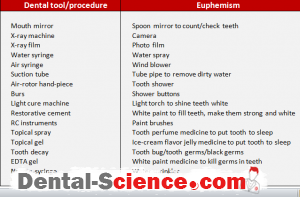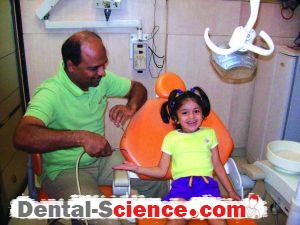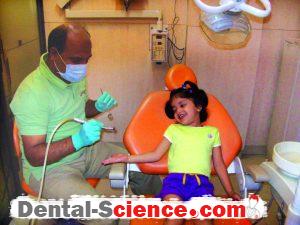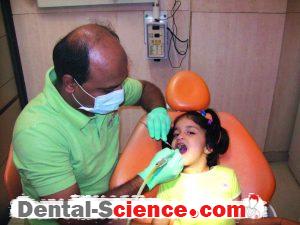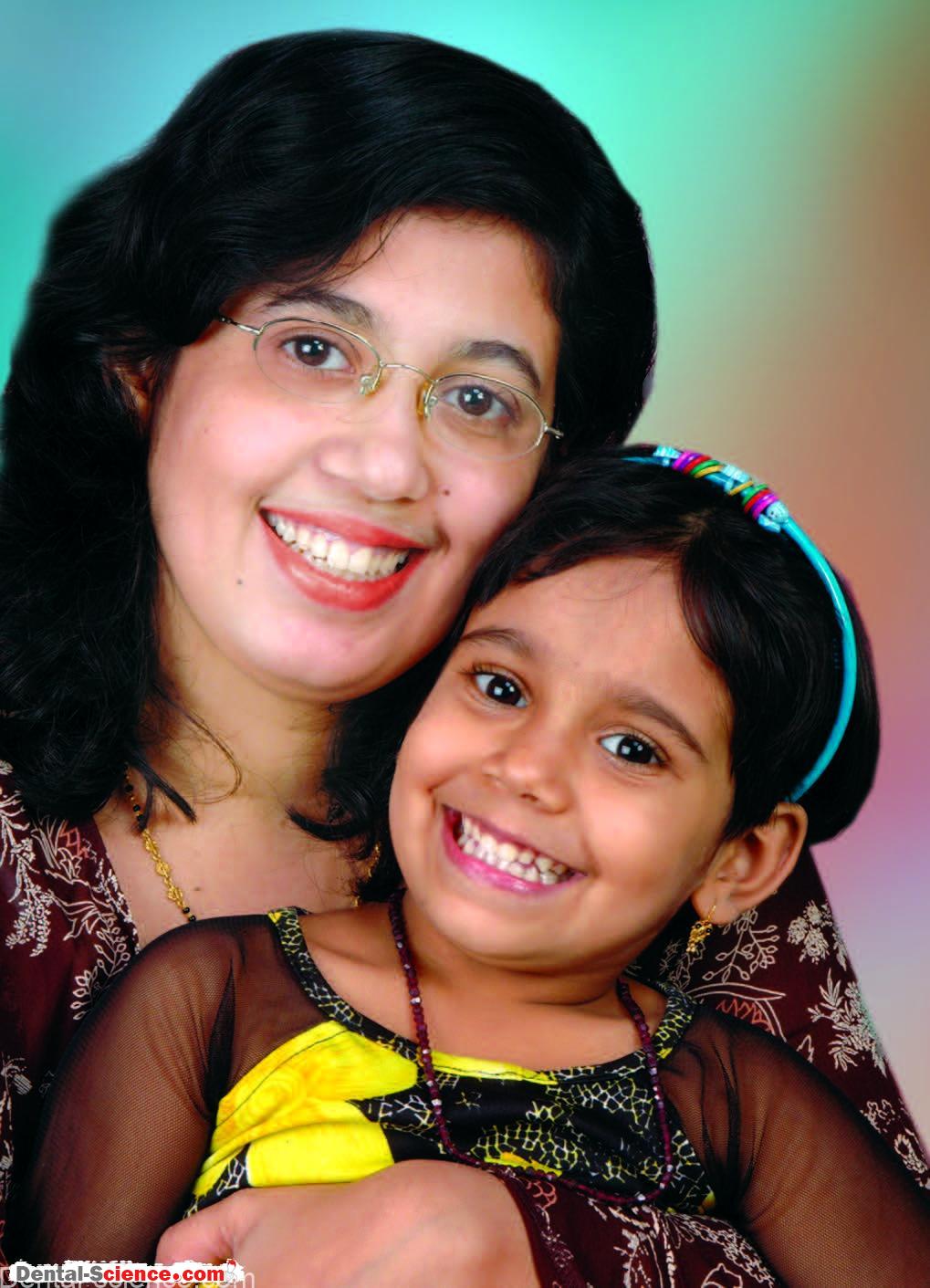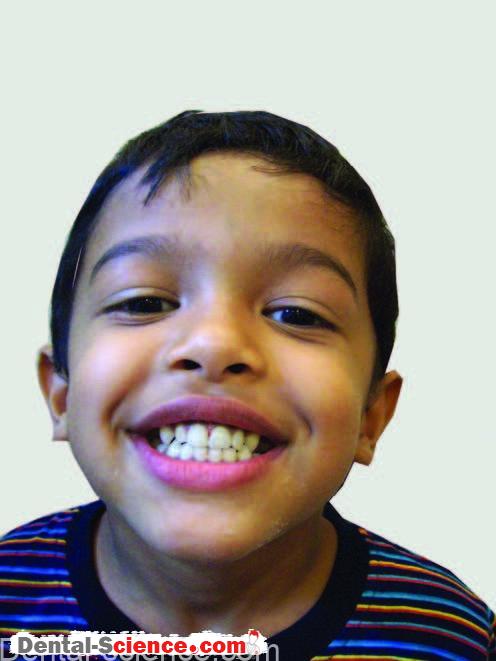– Tell Show Do is the most important behavior modification technique practiced by dentists.
– The technique is simple to understand but not so simple to practice.
– It is not just about telling something, showing something and doing it.
– It is a presentation given to a child for which the child may not be attentive.
– The telling something involves a lot of ‘NOT TELLING’, showing something involves a lot of HIDING by the dental team and doing means actually carrying out much more complicated treatment than what is TOLD or SHOWN to the child.
– The children often feel scared on their initial visits to dental clinics.
– Often parents threaten the children that if they misbehave, they would be taken to doctors who give injections.
– Also, children have bad memories of visiting a doctor/hospital and they recollect the same on their dental visits.
– The dentist thus has an arduous task of creating a fresh image of him/her, distinctly different from other doctors and medical people, in front of children.
– Also, the medical doctors or surgeons, unlike dentists, usually do not carry out long, delicate and complicated procedures on children without general anesthesia; and short procedures such as giving vaccine shots are managed by merely holding them.
– However, a dentist may have to perform treatment procedures that are technically sensitive to deliver and may be time consuming, too.
– The dentist has no choice but to gain child’s attention, build a rapport with him/her to
acquire his/ her cooperation and maintain good communication throughout, to instill
a positive attitude in the child’s mind about dentistry.
– The first meeting with the child must communicate to the child that there is nothing to fear about dentistry.
– The easiest way to achieve the same is by starting a conversation about a non-dental topic and keeping the dental experience of the child minimal.
– The interaction with parents, however, must begin well and their concerns regarding the
dental care must be addressed.
– The parents must be explained that the dentist is planning the treatment plan and behavior modification with their consent and understanding.
– The child on his/her first dental visit makes an impression about the dentist, the dental team and the ‘place’.
-The same may be in the dentist’s favor if the following happens on day one.
– The child must spend 20-45 minutes in a dental clinic during first visit in the following
manner:
• 10-15 minutes in waiting room/play area after being greeted and introduced to toys by the receptionist
• 5-10 minutes in consulting area with the parents to meet the dentist
• 1-3 minutes on the dental chair (either alone or on a parent’s lap) and for a very brief
introduction to dental operatory
• 5-10 minutes playing outside while parents in the consulting area or at front
desk before leaving.
– Also, the attire and mannerism of the dental staff, the child-friendly atmosphere of
the dental clinic, and the gifts and compliments given to the child help erase the preset notion of the child that a visit to a doctor is nothing but punishment and pain! Telling to a child about dentistry is not so easy.
– The dentist has to be imaginative, innovative and even spontaneous in using euphemisms.
– Also, for this first communication, the dentist has to participate with a lot of active interest and interact with the child.
– While starting communication, it is important to:
• Start with shaking hands, welcoming the child warmly and starting a conversation with him/her (Do not mind if there is no response!).
• Keep the conversation around the topics of interest to a child such as schoolmates, cartoons, games, etc.
• Maintain an eye-to-eye contact with the child.
• Establish non-verbal communication through facial expressions and physical contact like patting on the back, giving a clap.
• Give compliments to the child (and of course, find more and more reasons to do the same repeatedly!).
• Avoid discussing pain, injections, bleeding, etc in front of children.
– An example of such a communication is given below:
(Mihir, a 3-year-old boy has been brought to the dental clinic by both the parents for the checkup of his decayed teeth.
On arrival at the clinic, he is greeted by the clinic receptionist, who showed Mihir a fish tank in the waiting area and introduced him to a slide in the play area.
He also sees the black-board on the wall like one in his school, where a girl has been busy drawing a picture.
After spending good 10-15 minutes there, Mihir’s parents are instructed to take Mihir to the doctor’s cabin.)
– The following interaction continues there:
Doc: Please come in! Hello! What is your name? (Pausing for a reply) Will you shake hands with me?
Mihir is apprehensive and turns his face away from the dentist and clings to his parents.
Doc: Well, I know your name, Mihir! (The receptionist has already handed over the case paper filled with necessary information gathered from parents while Mihir was playing) And I also know that you are from Little Tigers playschool. (Pausing again) What a nice t-shirt you have! It has a picture of Tom and Jerry! Do you like Tom and Jerry?
Mihir still does not respond, but has started listening to the dentist.
Doc: I’m sure you are a good boy. Mihir, shall I now talk to your daddy?
Here, the dentist asks a few questions to Mihir’s parents and records his chief
complaint and related medical and dental history.
The dentist also explains to the parents that only after a brief checkup of his teeth he/she would be able to give them further advice.
Also, since this is his first visit to a dentist, he would not be asked to sit on the chair for more than a couple of minutes.
Doc: (Enters the operatory with parents and Mihir) See Mihir, we have a chair here, on which good children like you sit and show me their teeth.
Can you see the cartoon channel on TV in front that we have put on for you?
Also, this chair is a great ride… it moves up and down! We have a light to see your teeth better and a small spoon mirror to count the teeth. Do you want to hold one and see
yourself?
– If Mihir does not respond, one parent holds him on the lap and allows the dentist a brief
examination of his teeth.
– The dentist gives compliments to Mihir for being a ‘good boy’ and hands over a gift to him
(a small car or a tooth brush) and pats him on his back.
The dentist now escorts them back to his cabin for further discussion.
– Mihir is allowed to go to the play area again or may remain with parents, depending on his wish.
– Through such a communication, the dentist gets a fair idea whether the child is responding or not.
– It is imperative that the dentist does his job of talking to the child.
– The child’s response may not be instant and an instant response may even be negative.
– However, persisting with the communication in such a manner achieves the desired outcome later.
– The behavior modification is most essential for children who are entering cooperative age group (i.e. who are in a preschool passage).
– According to Pinkham (the author of ‘Pediatric Dentistry from Infancy through Adolescence), no child is competent in language before the second birthday and all normal children are competent in language after fourth birthday.
– Usually during 3-6 years of age:
• Fear of separation from parents, strangers, and new experiences diminishes
(by the third birthday)
• Self control develops
• Conscience develops
• Aggression (either instrumental or hostile) develops
• Interaction with peer, self-discipline, values (sexual as well as adult) develop
– Therefore, this age-group children are amenable to behavior modification.
– They can be influenced because they are susceptible to:
• Distraction
• Friendship
• Feeling guilty
• Praise
• Emotions of other people.
– The dentist can achieve their cooperation with a properly thought out and thoroughly
executed plan of verbal communication.
– It is important to create a fantasy in the child’s mind regarding the dental care
he/she is going to receive.
– The fantasy is nothing but a well-laid trap in which the child enters as per the dentist’s wish and starts cooperating for dental care.
– The communication must involve questioning the child and also making him/her understand a few statements.
– The questions must, however, be ‘leading’ questions.
– The child while answering them commits to the dentist his/her cooperation and thereby
enters the trap!
– The following can be the sequence of statements to be made by the dentist for interaction with the child:
• Are you a good boy/girl?
• Do you want to have good white teeth?
• Will you help me make your teeth white and good looking?
– These questions are often answered positively by children. Note that the last question has a ‘condition’ in it.
– The child has chosen to accept it by now. (Remember, it cannot happen all of a sudden.
– While you gave the child an overall good experience in the first visit, the child has observed you and has at least found you harmless!
– Now the child accepts this condition with caution.
– Now is the time to ask for further commitment!
– For that, the following statements are noteworthy:
• We help only good boys/girls to get good white teeth.
• We give nice gifts to only good boys/girls.
• If you promise me to help me, only then I’m going to make your teeth shine white!
– By now, the child has agreed to most demands and has shown initial willingness to comply. (He/ she knows that crying is still an option if things go wrong!)
– The actual Tell-Show-Do can now begin:
• Have you seen your teeth in a mirror?
• Have you seen these black spots, holes in your teeth?
• Do you know these black spots are tooth germs causing damage there?
• Do you wish to have all good shining white teeth?
• Let me show you how to clean teeth and make teeth white…
• See, this is a water–spray (demonstrate on the hand)
• And see, this is an air–spray (demonstrate on the hand)
• Look, this is a tooth-cleaning shower. See, it cleans so fast! (demonstrate on the hand)
• We have a nice white paint for your teeth to make them good-looking! We have a blue light torch to shine them bright, too!
– In the continuation of the same most dental tools can be demonstrated, too! The dentist must be ready with several euphemisms (substitute words) for them!
– Some of the commonly used ones are given below:
– In the initial visits, a few small procedures such as taking radiographs, fluoride varnish
application, and small restorations can be completed.
– If the child’s cooperation is satisfactory, the procedures requiring local anesthesia
administration can be subsequently taken up.
– If there is a failure in achieving full cooperation, the small procedures may still be continued with parent’s assistance (without much force) and a different behavior modification
technique (such as modeling, parental separation, voice intonation, etc.) is considered at the next appointment.
– The SHOWING part of TSD includes hiding as well as not prominently displaying a few objects in the dental operatory.
– The following are the examples:
– After demonstrating a dental procedure to the child by telling him/her adequately and
showing him/her the necessary tools, the actual skill of the operator comes into play while
‘DOING’ the treatment.
– It is important that the child is not told lies or given any promises that the dentist is unable to keep.
– The dentist should not tell a child that the needle does not hurt in any case because if the child experiences pain later, he/she may lose faith in the dentist forever.
– Also, the TSD method only explains the child the procedures, but other method such as
distraction (by allowing the child to watch a cartoon program while carrying out the
treatment or engaging him in conversation) should be practiced to continue the treatment comfortably.
– The child once knows what is happening may not seek explanation for the treatment again and again!
– The TSD method is thus, the most important method in ‘conditioning’ a child to receive
dental treatments.

